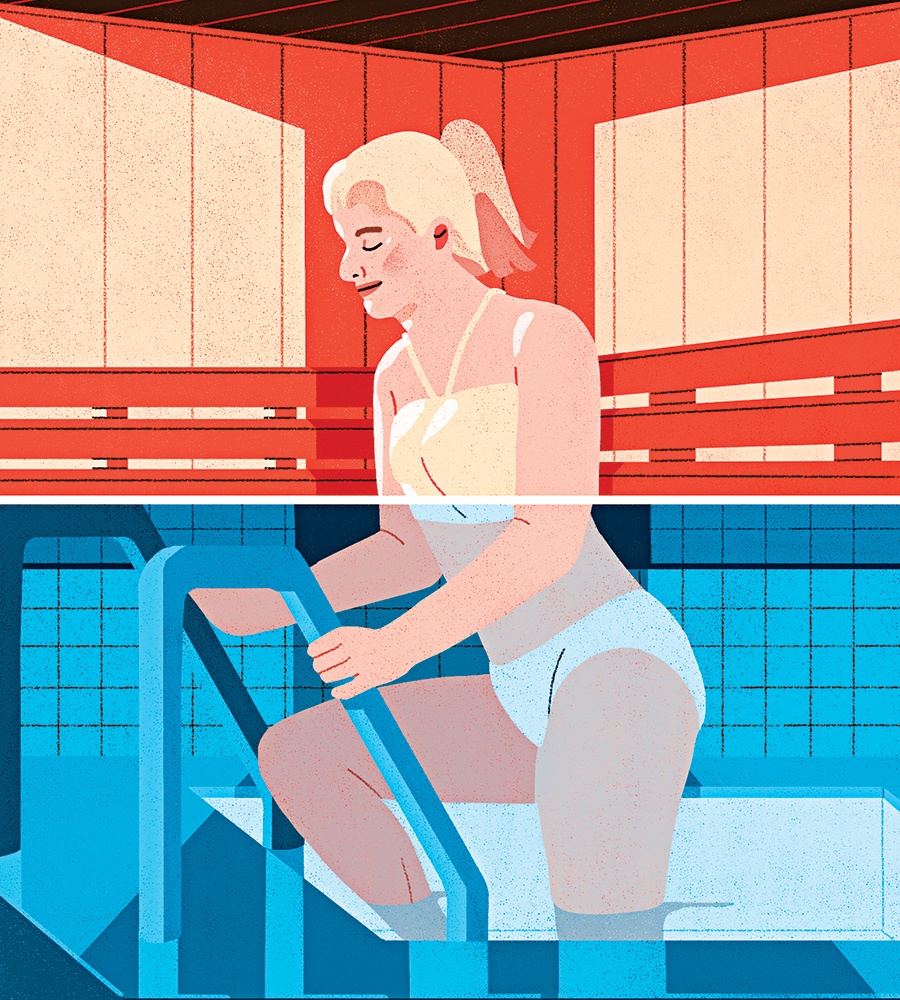I Hate Cold Water. Can I Handle Contrast Therapy?
Hot, then icy, then hot again—it's a wellness technique taking you on the ultimate temperature roller coaster. Our style editor tries handle the heat and the freeze.

Illustration by Jeannie Phan
I have a confession to make: I am the mom who rarely swims on vacation with her kids, even though I’ve spent all the summers of my life living a half mile from the beach. I dive into the ocean once, maybe twice a year, and only when the air temperature swells past 80 degrees.
The reason? I’m somewhat embarrassed to admit this, but my tolerance for cold water is abysmal. So it was with extreme hesitation that I agreed to try a “Contrast Method” class at the Back Bay’s recently opened Release Well-Being Center. An offshoot of the increasingly popular wellness trend known as contrast therapy, the 45-minute class harnesses the power of alternating sauna and cold-plunge sessions, which is said to improve circulation, boost immunity, reduce inflammation, increase metabolism, and decrease stress and anxiety (unless, of course, you hate the cold like me).
When I arrived for my session, however, my nerves were instantly settled by instructor Heather Vroman, who promised that we’d ease into the icy water at my pace. Three other friendly women were in the class, all of whom were familiar with the benefits of contrast therapy. In addition to the physical gains, Vroman noted that the divergence between hot and cold also offers mental and emotional rewards, “teaching us the importance of balance and resilience as we navigate the extremes of temperature.”
We started in the sauna, typically heated between 150 to 180 degrees, for 12 minutes. While it was hotter than I anticipated, time passed quickly as Vroman held our focus with conversations meant to foster connection among us, asking what we were grateful for. For me, it was my family and that I was fortunate to have a job I loved, though not as much on this particular day.
Following the sauna, it was time for a three-minute cold plunge. My anxiety spiked as I prepared to sink into the tub, cooled to 50 degrees. Vroman told us that was actually “warm,” as sometimes, the plunges are set to 37 degrees. Still, the frigid water shocked me, and extending my entire body into it felt torturous. Vroman and the other women—regular participants who were seemingly unfazed as they sank in up to their necks—encouraged me to focus on breathing, which helped considerably. Thanks to their coaching, I made it through the three minutes, though I couldn’t completely submerge myself. By my second plunge (the hot-cold cycle is repeated three times), I was able to sink a bit deeper.
As I hoisted myself out of the plunge, it dawned on me that in that short period of time, I’d forged a connection with my fellow participants: They’d seen me more vulnerable than some of my close friends had. As I left the spa, there was a pleasant buzzing in me. I felt exhilarated, like I’d just finished a long run, which is common. “The practice can lead to the release of endorphins, chemicals in the brain that act as natural mood lifters,” Vroman told me. It just might have been enough to propel me back for another session, or at least into the icy Atlantic with my kids on our next beach day.
28 Arlington St., Boston, 617-249-4032, releasewellbeingcenter.com.
First published in the print edition of the September 2024 issue with the headline, “Take the Plunge.”


